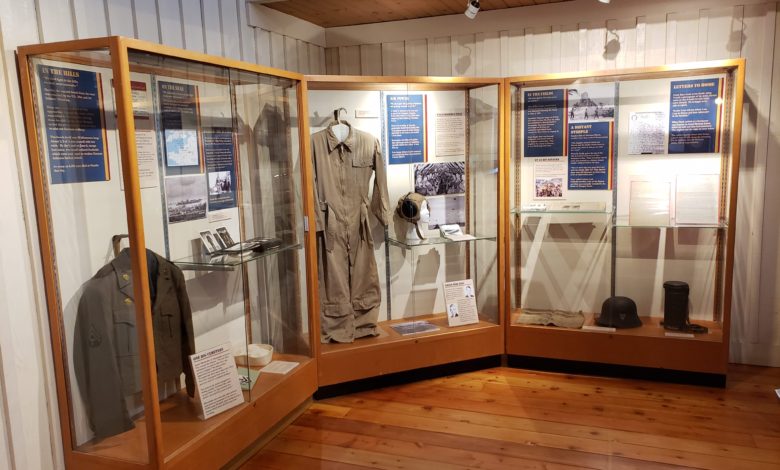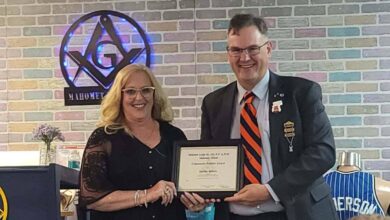D-Day stories come to life at Museum of the Grand Prairie

Coming onto a beach where more than 4,000 Allied soldiers and another 4,000 Axis soldiers have lost their lives, is something that the world has only seen, and may only see, once.
Operation Overlord, also known as D-Day, is widely remembered on June 6 each year, but those who were there and can recall the stories, are few 75 years later.
In the early 1990’s, the News-Gazette captured 240 interviews from men who fought in D-Day or landed in Normandy, France, days after the largest seaborne invasion in the world’s history. Those tapes were then passed on to the Museum of the Grand Prairie in 1995.
Shortly after June 6, 2019, the Museum of the Grand Prairie finished its special exhibit: “We Saw Them on the Beaches: D-Day and beyond from a Local Perspective,” which will be available until Oct. 14.
Museum Director Barb Garvey decided to take a personal approach to the exhibit.
“I like doing it about one or two people,” Garvey said. “Because it tells a human story.
“It’s not about equipment. It’s not about us versus them. It’s about people.
“And that’s why this matters.”
Of the 240 recordings, Garvey pulled out stories about Champaign residents Frank Byra, James Mitsdarffer, Irvin Bloom and Charles Pearson, Newman resident Stephen Kish and Mahomet resident Carl Hatcher.
Byra, a member of the Navy who landed in Normandy 10 days after the initial invasion to take supplies to the troops, picked up German paraphernalia and sent it back home. Alongside the German potato sack, gas mask canister and a helmet, he also found a letter that was translated into Engish by the University of Illinois.
The letter, which was located in a farmhouse and dated March 3 said, “They talked very much about the invasion that is to come this spring, but I don’t believe it. If such a thing would happen to come, they would not talk much about it. Anyhow it would be a fruitless invasion. I know the storm of the Atlantic too well, and you will learn it. Meanwhile, the wall in the West is unbreakable.”
Garvey commented, “So basically, the Germans think that that’s just a lot of talk. And the wall in the West, meaning their defenses are unbreakable.
“They had no idea that the biggest attack in all of human history was going to happen. it’s disturbing, but also really cool.”
Garvey also included a letter that Byra wrote home.
Byra wrote, “I am taking part in the invasion. I am fine in fine health and have not received any injuries. But I have learned a few things and have had some trying experiences.”
“Everybody writes home, right?” Garvey said. “You have to remember that these guys have humanity, too.”
Kish talked to the News-Gazette about the devastation along Omaha Beach.
“He turned around and he said he saw a battleship on fire,” Garvey said. “I think what was happening was that they were firing and they look like they’re on fire. He turned around and looked the other way, and the church steeple he had just seen had gone away.”
Garvey believes that while the Allied troops tried to preserve some of the cultural monuments during their attack, they also had to destroy some that they believed the Axis forces were using. Garvey said Germans may have been using the top of the steeple as an observation point.
Another man, whose story is not part of the exhibit, said he felt confident as he was dropped into the water.
“They got really confident because there were so many ships and there was so much equipment. And he said as they got out, it was like a cemetery with the people who hadn’t been buried yet,” Garvey said.
She also told another story of a man who had to find his way to shore after the aircraft carrying his platoon dropped them into the water.
“They had to swim with their full packs on to get to the shore,” she said. “The fellow said he was standing on the shore and the bodies were waving in and out with the waves and he ran through them.”
While D-Day is infamous for the sea attack, Allied forces also used gliders to bring men and equipment in behind the Axis forces.
“They put men on the gliders, but they also put on equipment like Jeeps,” Garvey said. “Then they just sent them on beyond the German lines so that they would be able to attack immediately. While the Germans were fighting on the beach they would also be hit from behind.”
Bloom and Pearson died during or after the aerial attacks.
Garvey said while the D-Day exhibit is full of recollections of D-Day survivors, it is important to pause and remember those who didn’t make it.
“This is based on the guys who got to come home and tell a story, but many men never get to tell their story,” she said.
Mahomet’s Hatcher was part of the 82nd Airborne Division and some of the first to arrive at the scene.
“He was so weighed down,” Garvey said.
“When it was time to jump, somebody had to help him up.
“So imagine jumping with that on your back; it seems like you would be doomed to fail.”
Byra’s German collection extends into the Airborne area of the exhibit where visitors can see part of a barrage balloon, a large kite balloon used to defend against aircraft attack.
Garvey is grateful for the connections she has made with some of the men, most of whom have passed, and their families over the last two decades. Without those connections, the exhibits, the stories, and display items would not be possible.
It is through these connections, that Garvey has also been able to listen to more of the men’s stories.
Byra was stationed in Dartmouth, a British port. He was given secret packets to deliver along the Dart River.
Garvey remembers, “He said, ‘I wasn’t supposed to know what I was doing, but of course I knew. I’m just a kid and I’m taking these secret packets to all the captains of all the ships.’ ”
Byra’s daughter disclosed a little bit more.
“He found out later, people were directed to shoot him on sight if they thought there was a leak; if they thought he’d opened it,” Garvey said.
The D-Day exhibit won’t be the last one at the Museum, though. Garvey plans to display stories about women in the military during WWII, then V-E Day and V-J day within the next 12 months.
She hopes that the stories help people remember the sacrifices made.
“I always hope (people) take away some measure of humility,” Garvey said. “That you know, these people did this for us.”





